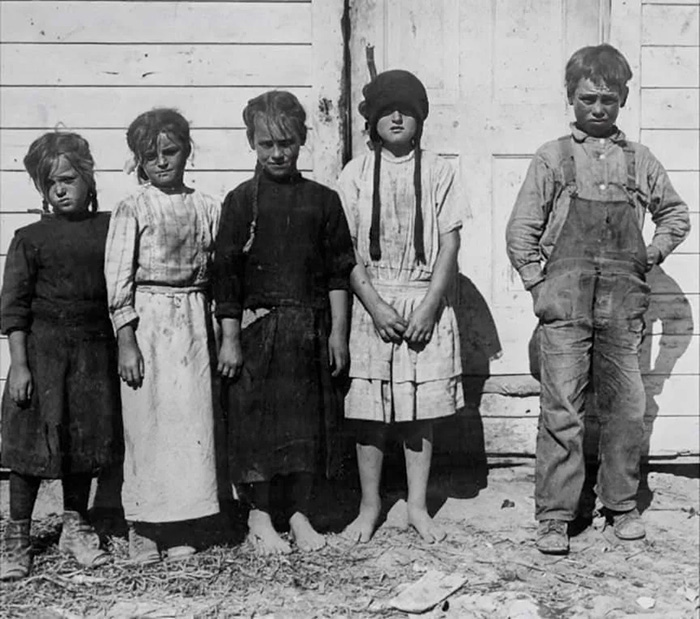
Children belonging to families of Stark and Schwartz, beet workers near Sterling, Colo. Family, including children, work from 5 A.M. to 6 P.M, with only half an hour for lunch, a work-day of over 12 hours. Sterling, Colorado, 1915
From the colonial era onwards, child labor was woven into the fabric of American society. Necessity, not malice, often defined the lives of children, who contributed to farmwork, apprenticeships, and home-based industries.
However, with the dawn of the Industrial Revolution in the 19th century, the nature of child labor shifted dramatically. Factories beckoned, their voracious appetites easily satiated by the nimble fingers and small statures of children. Textile mills, mines, and glass factories became the new playgrounds, echoing with the clatter of machinery and the hollow coughs of dust-choked lungs.
Children, as young as eight or ten, toiled alongside adults, often for longer hours and at considerably lower wages. Their tiny hands fed machines, navigated narrow mineshafts, and endured repetitive, soul-crushing tasks. Hazards lurked around every corner: mangled limbs caught in gears, lungs ravaged by coal dust, minds dulled by monotony. Education, play, and childhood itself were luxuries afforded to the privileged few, sacrificed at the altar of economic progress.
Yet, amid the clamor of industry, dissent arose. Progressive reformers, journalists, and photographers documented the grim realities of child labor, their poignant pictures and impassioned narratives igniting a public outcry. Lewis Hine’s haunting photographs of child mill workers, Jacob Riis’s unflinching exposés of tenement life, and Upton Sinclair’s novel “The Jungle” laid bare the human cost of unchecked industrialism. Slowly, the tide began to turn.
The first legislative steps towards reform were tentative, often hampered by powerful industrial lobbies. State-level measures emerged piecemeal, with Massachusetts enacting the first meaningful child labor law in 1874. However, the fight for national legislation proved arduous. Numerous bills were defeated, bogged down in political wrangling and concerns about economic disruption. It wasn’t until 1938, with the passage of the Fair Labor Standards Act, that comprehensive federal protection for child laborers was finally secured.
This landmark legislation established minimum wages, limited working hours, and prohibited the employment of children in hazardous occupations. While not eliminating child labor entirely, it dramatically curtailed its prevalence and ensured that generations to come would have the right to an education and a childhood free from exploitation.
However, the legacy of child labor continues to echo in contemporary debates. Issues of migrant children employed in agriculture, exploitative work conditions in developing countries, and the increasing presence of children in the online gig economy remind us that vigilance is still necessary. The struggle for children’s rights is an ongoing story, a testament to the enduring belief that every child deserves the chance to flourish, not toil, in the tapestry of human experience.

Theodore Lee is the editor of Caveman Circus. He strives for self-improvement in all areas of his life, except his candy consumption, where he remains a champion gummy worm enthusiast. When not writing about mindfulness or living in integrity, you can find him hiding giant bags of sour patch kids under the bed.
